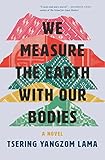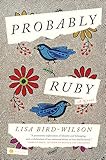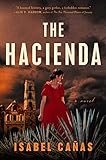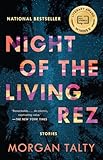Adoption narratives, genre-bending novels about the horrors and inequities of life, and promising collections round out this season’s notable fiction debuts, some of which are already making their way to a TV near you.
Decolonize This: Lisa Bird-Wilson
Like Ruby, the protagonist in Probably Ruby (Hogarth, Apr.), Saskatchewan Métis and nêhiyaw writer Lisa Bird-Wilson was raised by adoptive white parents in the 1970s, during a decades-spanning period when Indigenous children were systematically taken from their biological parents by the Canadian government and placed into foster care.
Ruby is Bird-Wilson’s U.S. debut. She published her first book in Canada in 2011, a work of nonfiction commissioned by the Gabriel Dumont Institute for Métis education and culture, an organization she now heads. A story collection followed, and then a book of poems. In 2016, she returned to fiction.
“I just started writing stuff about being adopted and being indigenous,” Bird-Wilson says.
Ruby is meant to embody and connect to a multitude of Indigenous perspectives, not just her own, and Bird-Wilson notes that the character came to her after speaking with white people who had adopted kids like her and responded defensively to her story collection at book events. Her work challenged the “colonial myth” that they had saved their adopted children from some kind of “horrible fate,” she says.
David Ebershoff, editor-in-chief at Hogarth, says Probably Ruby is an “in-house favorite” that stood out to him for two reasons. First, he’d never come across a story of an Indigenous adoptee; and second, he felt “great affection and love” for the character. He also pointed out that while it’s a story from Canada, it will resonate with readers in the U.S. It’s “not just a Canadian story, it’s a North American story,” he explains, in that it shows how for the Métis and other Indigenous peoples, the border is porous. The author adds that it’s “artificial.”
Bird-Wilson recalls that Ruby felt real to her after she discovered her laugh, which Ruby uses to protect herself—whether to dismiss her feelings or to shrug off other people—and to express genuine joy. “That’s when her character was able to just go and be as wild as she is,” she says.
A Recovered Goth: Isabel Cañas
Berkley editor Jen Monroe has high hopes for Isabel Cañas’s The Hacienda (Berkley, May), a reimagining of Rebecca in 19th-century Mexico. “I think we’re moving away from traditional suspense, and horror feels like the natural next place for domestic suspense,” Monroe says. She also notes how recent successful books like Silvia Moreno-Garcia’s Mexican Gothic have opened the door for commercial genre fiction that takes on racism.
Cañas, a Mexican American writer and PhD candidate in medieval Islamic literature now living in New York City, says she anticipated the Mexican Gothic comparisons and figures her timing helped land her a swift, competitive book deal last September. She greatly admires Moreno-Garcia, noting that they come from the same “very nerdy sci-fi fantasy and horror short story background” and that her success was inspiring. Still, she’s quick to point out that she’s “not a copycat.”
The Hacienda touches on similar themes of Mexican history—colorism, class difference, “the question of who holds land and who holds power, is echoed between the two books,” Cañas says—but it goes further than Mexican Gothic into the supernatural realm. Real ghosts haunt the house, and the protagonist, a young bride turned widow, relies on a priest friend’s witchcraft skills to ward them off.
Asked what drew her to writing a haunted house story, Cañas says she continues to be as afraid of the dark as she was at eight, growing up in a house built in the 1920s in the Chicago suburbs that she swears to this day was “totally haunted.” She began writing fiction with a series of YA manuscripts that she worked on with her agent, Kari Southerland at Bradford Literary, inspired by her interest as a “recovered goth child” in her Mexican ancestry, theology, and the Aztec gods of death and sorcery.
Cañas started The Hacienda in November 2019 and finished it at the beginning of the Covid-19 lockdowns in a tiny Brooklyn studio after moving there from Chicago. “I was trapped in a tiny space,” Cañas says. “I think back to everybody being trapped at home, and I’m like, of course this was finished during lockdown. Could it have become itself at any other time?”
Love Life: Kate Folk
It’s rough out there in Kate Folk’s slightly tweaked present-day San Francisco. Male catfishing androids known as blots haunt dating apps, pretending to be viable boyfriend material until they get close enough to steal their target’s passwords and credit card info. So goes the setup of the title story in her debut collection, Out There (Random House, Mar.). After the story was published in The New Yorker last year, she signed a deal with Hulu to write an adaptation.
Lots of literary fiction writers are getting TV writing gigs and development deals nowadays. Folk says films are an influence on her work, but that she doesn’t write fiction with adaptations in mind. “When I wrote the stories, I felt like they were two completely separate fields, and I didn’t really know anyone else doing that kind of thing,” she recalls. But after film agent Will Watkins approached her agent, Emma Patterson, at Brandt & Hochman for something that might be well suited for adaptation, Folk says Watkins “immediately latched on to” her stories.
Folk does have a long-standing interest in film—she’d always wanted to work in the industry or become a director, and she worked at Videology in Brooklyn after graduating from NYU before moving to San Francisco in her 20s. She wonders if her interests as a writer happened to coincide with what might make a good movie, or if it’s simply a matter of good timing, given the film industry’s increased appetite for speculative stories. Whatever the case, “fiction writers do have a bit of leverage to adapt materials,” she acknowledges. “I’m coming in as a writer with ‘existing IP,’ as they call it, which seems like a really good way to get a foot in the door.”
Folk arrived in San Francisco a few years before the ubiquitous tech bros who represent the mediocre alternative to the blots in her stories. As the cost of living increased, she got by with teaching and support for her writing at the Headland Center for the Arts, which gave her a studio, and most recently with a Stegner Fellowship.
The stories in Folk’s collection represent years of work. In the end she’s pleased to find them cohering into something larger, with an emotional arc and the feeling of a “concept album.”
Welcome to Flavortown: Joseph Han
 A Korean American family’s restaurant in Honolulu provides the nexus for Joseph Han’s ambitious and occasionally supernatural novel Nuclear Family (Counterpoint, June). Cho’s Delicatessen is poised to take off after getting its airbrushed seal of approval from Guy Fieri, but the business’s reputation is compromised after 20-something grandson Jacob is caught on video attempting to cross the Korean Demilitarized Zone.
A Korean American family’s restaurant in Honolulu provides the nexus for Joseph Han’s ambitious and occasionally supernatural novel Nuclear Family (Counterpoint, June). Cho’s Delicatessen is poised to take off after getting its airbrushed seal of approval from Guy Fieri, but the business’s reputation is compromised after 20-something grandson Jacob is caught on video attempting to cross the Korean Demilitarized Zone.
Han was born in South Korea, and his parents sent him to Hawaii as a child to live with his grandparents. At the time, his grandfather worked at a restaurant. He says the story came partly from imagining what his family would be like if they had stayed in the industry, and from his ruptured relationship to Korean language and history as a result of his English education.
When Jacob attempts to cross the DMZ, it’s because his body has been possessed by the ghost of his grandfather, Tae-woo. Tae-woo’s home was on the northern side of the border, but he died in the south, and he’s spent his afterlife trying to return.
Nuclear Family is also a Hawaii story, and Han brings the two places together by featuring the 2018 false missile alert on the islands, which happened just before he began the first draft. “I found it was something I had to write toward and process,” he says, noting that the renewed blame of North Korea for the continued tension was frustrating, and that “Cold War relics” like the siren “continued to propagate a fear for one’s own safety.”
Han tackled the relationship between Korean Americans and the U.S. military in Hawaii in an earlier story titled “Fare,” in which Korean cabbies drive military families to tourist destinations. Published in Joyland, where he’s now an editor, it caught the attention of agent Danielle Bukowski at Sterling Lord Literistic, who now represents him. “I was so excited to hear from her,” Han says, “because she represents Bryan Washington, one of my favorite writers.”
His editor at Counterpoint, Jenny Alton, says she was struck by the “humor and playfulness” in the writing, even as the book takes the reader through heavy themes of American imperialism and war.
On writing as a resident of Hawaii toward an outside audience about both Hawaii and Korea, Han says it was a “really nice goal to take on both in such a way that the reader can understand how these histories and our communities are entangled.”
Nightclubbing: Calla Henkel
Artist and writer Calla Henkel spent a year in Berlin right after the trial of Amanda Knox, an American student convicted of murder in Italy and later exonerated. The case inspired Henkel’s debut novel, Other People’s Clothes (Doubleday, Feb.), about two art school friends who room together in a true crime author’s apartment in Berlin and concoct an idea for a performance piece inspired by Knox that goes disastrously awry.
“I wrote this book more or less true to the timeline of my own year abroad, but filled it with pulp,” says Henkel, who now operates New Theatre, a bar and performance space in Berlin below her apartment. With her collaborator Max Pitegoff, she has exhibited documentary photography installations around Europe and at the Whitney Museum in New York City. She’s always had an interest in thrillers and grew up reading authors such as Carl Hiassen. “Thrillers are like math problems,” she says, “and I think there’s a type of poetry in that sort of math.”
In Other People’s Clothes, which is in development with Mark Gordon Pictures, Hailey, a young woman aware of her sexual power and objectification, becomes jealous of Knox for the attention she received. “How do you harness that power is I guess Hailey’s question,” Henkel says. “She’s like, ‘If I’m gonna be abused and used for my image, how can I in the end own it?’—which is why I find Amanda Knox’s Instagram so interesting, and also Brittany Spears being like, ‘Now I have my own Instagram.’ ”
Lee Boudreax, executive editor at Doubleday, notes Henkel’s ingenious choice to set a story of image-conscious young women just before the rise of social media, and immediately recognized it as a timeless story of female friendship. “It’s about the road from innocence to experience, where one woman kind of gloms onto the other in the hopes of being brought through that doorway into the hidden room beyond,” Boudreax says. While reading it during the first summer of Covid-19, she felt “completely transported to some hot sweaty druggy nightclub,” she says, “and I cannot tell you how much I loved that.”
The Double: Zain Khalid
Zain Khalid, a New Yorker whose Believer essay “How to Make a Bodega Sandwich” carries a particular resonance for those who left the city over the past couple years, fulfilled his lifelong dream of writing a novel with support from savings earned from punch-up work on TV scripts and other writing gigs. His bold, ambitious debut, Brother Alive (Grove, July), features three adopted brothers raised by an imam in Staten Island, including Youssef, a boy of Middle Eastern descent who has a double named Brother.
Khalid says the theme of the double has long captured his interest. “You know, keeping with that long literary tradition, the classic exploration of the Jungian shadow or whatever…,” he says. “But I also wanted to build the double as a sort of sublimation of structural theft, to explore what families, governments, the past, and even lovers can take from one another, and what kind of person that leaves behind.”
As for literary influences, Khalid says, “I pulled from a lot of places—Bruno Schulz, José Saramago, Akwaeke Emezi, James Salter”—he trails off, indicating that the list could go on much longer.
It’s a New York story, with rich descriptions of Staten Island’s Coolidge neighborhood, and it’s also a speculative story of a futuristic city in Saudi Arabia, which the brothers visit when they’re older. Khalid says it had to be set in New York because that’s where he grew up. “All the boroughs except for the Bronx, which is a stain…,” he jokes, adding that he’ll have to “move to Arthur Avenue and eat a lot of Italian food.” The city in Saudi Arabia draws on Mohammed Bin Salman’s Vision 2030 program, he adds, noting that “the cost of that city is born out in the tragedy at the center of the lives of the brothers.”
Agent Kent Wolf at Neon Literary says he discovered Khalid from a New Yorker “Shouts & Murmurs” piece, and that Khalid is “probably one of the most well-read writers I work with.” He says this is evident on the page, “but there’s also a real beating heart to his work, which makes it a living thing rather than an exercise.”
Peter Blackstock, v-p, deputy publisher at Grove, also references Emezi, saying he recognized the imprint of the Nigerian writer’s work when he read the manuscript, and was surprised and impressed by the shift to Saudi Arabia. “It blew me away with how much there was,” he notes. “It’s not a long novel, but it contains a huge amount.”
Vampire Daughter: Claire Kohda
As a British writer who is half Jananese, Claire Kohda says it took her a long time to figure out which literary heritage she could claim as her own, and which space she belonged in. “A lot of my earlier attempts at writing were too consciously Japanese or too consciously kind of English,” she says. “Or I was trying to be this thing that I wasn’t.”
As a critic, she’s happy to review literature in translation from Japanese, sometimes from Korean and Chinese as well, but doesn’t want to get pigeonholed for her own writing because of her ethnicity, such as having a book come out with a “Japanese woman’s face on the cover or a rising sun, or like chopsticks or something.”
A path forward came to her with the idea for a vampire story, which became Woman, Eating (HarperVia, Apr.). “The vampire worked because it’s this divided creature by nature,” she says. “It has a human body and human memories, but it has this demon side as well.”
Lydia, the young woman at the center, is an artist and a vampire with a complicated relationship to food. She’d love to eat sushi, but all she can have is blood, which her Malaysian-English vampire mother prepares for her. When her mother moves in to a nursing home, Lydia begins exploring her late father’s Japanese heritage.
Kohda’s editor at HarperVia, Tara Parsons, has a Japanese mother and says that at this stage in her career, she’s looking for books with stories she can see herself in, which made the manuscript instantly exciting for her. “There are so many layers to the book,” she adds, noting that the short length and propulsive story have helped it quickly build early buzz among booksellers.
Now Kohda is at work on an eight-part TV series adapted from Woman, Eating, after it was optioned by Heyday in a heated auction. “So much of the novel takes place inside Lydia’s head,” she says, describing the challenge of rewriting the story for the screen. “With TV you can’t just have her rolling around on the studio floor doing nothing. So it’s been interesting translating her kind of inner world into a visual world.”
A Long Journey: Tsering Yangzom Lama
 Tsering Yangzom Lama was raised in a community of Tibetan exiles in Nepal. In Canada, where she settled with her family as a preteen, she began to see that she could become a writer, but it was a long time before she worked her way into writing about Tibetan people, the subject of We Measure the Earth With Our Bodies (Bloomsbury, May).
Tsering Yangzom Lama was raised in a community of Tibetan exiles in Nepal. In Canada, where she settled with her family as a preteen, she began to see that she could become a writer, but it was a long time before she worked her way into writing about Tibetan people, the subject of We Measure the Earth With Our Bodies (Bloomsbury, May).
“There were decades of knowing the Tibetan identity to be really central to my family,” says Lama, who went on to become an activist for Tibetan independence and now works for Greenpeace as a storytelling adviser. But she had a hard time finding a way in through the “world of letters or literature,” she recalls, because she doesn’t come from an academic or literary background. “That’s not necessarily something that was central to my experience.”
In the novel, two young sisters flee their village in Tibet after the Chinese invasion in 1959. Their parents don’t survive the journey to Nepal. Once there, Lhamo, the oldest, encounters a man bearing a statue that had escaped destruction by the Chinese authorities and is alleged to have healing powers. Decades later, Lhamo’s niece, a scholar who lives with her in Toronto, comes across the statue, which had been loaned to a museum by an art dealer, and suspects it was stolen.
Lama and her agent, Michelle Brower at Aevitas Creative, met at an AWP event several years ago. Brower says she was struck by the quality of her writing, and that one of the things they talked about was that the novel is “not a book for white people about Tibet.”
Lama says, “When I think of the people who would really love a book that’s anti-colonial with a level of historical detail, it’s like maybe a hundred folks that are my good friends already.” Still, she aims for a big audience. “I want everybody to read this and understand it, but I’m also really trying to capture Tibetans’ sensibility.”
Brutal Honesty: Brendan Slocumb
In Brendan Slocumb’s high-velocity debut mystery, The Violin Conspiracy (Anchor, Feb.), a Black 20-something violinist is on the rise in the classical music world despite blatant racism. Then, his heirloom Stradivarius is stolen from his hotel room in New York City.
Slocumb, a classical violinist who lives in Washington, D.C., has performed with many symphonies and currently plays with the NOVA-Annandale Symphony Orchestra. Asked what he wanted to convey about the classical music world in his novel, he says, “I wanted to pull back the curtain and let everybody know this is how the sausage is made. Classical music is a very cutthroat profession, though it’s especially tough for people of color. And for a Black man in classical music, you know, we are almost nonexistent.”
In The Violin Conspiracy, Ray is refused entry to a wedding that he was hired to play at. When he was in college, fellow students muttered about him being there to fill a quota. At one point, a symphony’s music director assumes he would want to play Gershwin instead of something by one of the “ ‘real’ European composers,” Slocumb writes.
Slocumb’s agent, Jeff Kleinman at Folio Literary, says he immediately latched onto Slocumb’s voice when he received a query. They worked together on a number of story ideas last summer, and Kleinman said the one about the stolen Stradivarius had the most potential. Slocumb banged out a draft in a few months. By November it sold to Edward Kastenmeier at Anchor, and Kleinman and Slocumb already have another one in the works. When they spoke with PW, it was during a break from a day spent working on edits.
“Jeff is really good about keeping me on a schedule for writing,” Slocumb says. He also notes Kleinman’s brutal honesty with Violin Conspiracy, which helped push him to bring “every bit of emotion out of a sentence.”
A New Master: Morgan Talty
“Burn,” the opener of Morgan Talty’s collection Night of the Living Rez (Tin House, July), evokes the short, sad misadventures in Denis Johnson’s Jesus’ Son. A man gets stuck in a swamp during winter after passing out with the water frozen around his long braids, while his friend Dee tries to buy drugs without any money. Later, Dee makes a triumphant gesture at redemption with the dealer.
For a fan of Johnson’s work, the comparison forms with an instant, pleasurable shock. Talty’s agent, Rebecca Friedman, and his editor at Tin House, Masie Cochran, felt it too, as did the author Tommy Orange, who provided a generous blurb for the collection. The stories take an empathetic and unflinching look at reservation life for citizens of the Penobscot Indian Nation, a small community near Bangor, Maine, where Talty grew up.
The stories triangulate between the characters’ relationships to one another in their community and to the outside world. “I mean, obviously different cultures have different experiences with colonialism,” Talty says, reflecting on his potential audience. “But at the end of the day, I’m very focused on these characters’ problems and how they’re unique to themselves, but also how we experienced them on a broader level. I’m writing it for Penobscot people, but non-Native folks as well.”
The collection is shuffled with stories of a boy named David about growing up on the reservation and glimpses of the struggling Dee, who might be an older version of David. “It has that feeling that a novel gives you,” Friedman says, “because you’re seeing the transformation of a character over time.”
When Cochran received the manuscript, her first reaction was, “I can’t believe this is a debut writer.” Thinking through the comparisons to older white writers such as Johnson, Larry Brown, Raymond Carver, and Alice Munro, she says the book stands on the shelf with her “all-time favorite collections,” but that “maybe the most important thing to say is that there aren’t really comp
This piece was produced in partnership with Publishers Weekly.

















